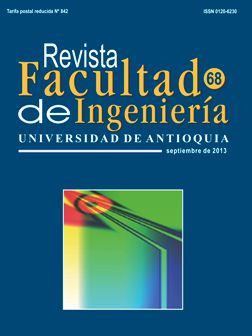Static and dynamic characteristics of turbulent flow in a closed compound channel
DOI:
https://doi.org/10.17533/udea.redin.17219Keywords:
mixing layer, hot-wire anemometry, coherent structures, compound channelsAbstract
The hot-wire anemometry technique was employed to study the velocity distribution and dynamic characteristics of the flow in two types of closed compound channels. The compound channels were built using two rectangular tubes attached to the walls of a wind channel separated by a distance d. In this configuration, a narrow gap is connected to a main subchannel. The results revealed an interesting flow that was quite similar to a mixing layer. All axial velocity profiles presented turning points at the main subchannel/ narrow gap interface. By using quantities from the mean flow velocity distribution, the flow could be described by a hyperbolic tangent function, and a Strouhal number was suggested as well. Regardless of the channel type, the dimensionless frequency was almost constant, resulting in a Strouhal number of approximately 0.10.
Downloads
References
L. Meyer. “From Discovery to Recognition of Periodic Large Scale Vortices in Rod Bundles as Source of Natural Mixing Between Subchannels—A review”. Nuclear Engineering and Design. Vol. 240. 2010. pp. 1575-1588. DOI: https://doi.org/10.1016/j.nucengdes.2010.03.014
D. Knight, K. Shiono. “Turbulence Measurements in a Shear-layer Region of a Compound Channel”. Journal of Hydraulic Research. Vol. 28. 1990. pp. 175-196. DOI: https://doi.org/10.1080/00221689009499085
L. Soldini, A. Brocchini, M. Mancinelli, R. Bernetti. “Macrovortices-Induced Horizontal Mixing in Compound Channels”. Ocean Dynamics. Vol. 54. 2004. pp. 333-339. DOI: https://doi.org/10.1007/s10236-003-0057-4
L. Meyer, K. Rehme. “Large-scale Turbulence Phenomena in Compound Rectangular Channels”. Experimental Thermal and Fluid Science. Vol. 8. 1994. pp. 286-304. DOI: https://doi.org/10.1016/0894-1777(94)90059-0
X. Wu, A. Trupp. “Spectral Measurements and Mixing Correlations in a Simulated Rod Bundle Subchannels”. Int. J. Heat Transfer. Vol. 37.1994. pp. 1277-1281. DOI: https://doi.org/10.1016/0017-9310(94)90212-7
M. Guellouz, S. Tavoularis. “The Structure of the Turbulent Flow in a Rectangular Channel Containing a Single Rod – Part 1: Reynolds-Average measurements”. Exp. Thermal and Fluid Sci. Vol. 23. 2000. pp. 59-73. DOI: https://doi.org/10.1016/S0894-1777(00)00038-8
E. Pitot, S. Tavoularis. “Gap instability of laminar flows in eccentric annular channels”. Nuclear Engineering and Design. Vol. 241. 2011. pp. 4615-4620. DOI: https://doi.org/10.1016/j.nucengdes.2010.08.025
D. Rowe, B. Johnson, J. Knudsen. “Implications Concerning Rod Bundle Crossflow Mixing Based on Measurements of Turbulent Flow Structure”. Int. J. Heat Mass Transfer. Vol. 17. 1974. pp. 407-419. DOI: https://doi.org/10.1016/0017-9310(74)90012-X
S. Möller. “On Phenomena of Turbulent Flow Through Rod Bundles”. Experimental Thermal and Fluid Science. Vol. 4. 1991. pp. 25-35. DOI: https://doi.org/10.1016/0894-1777(91)90018-M
L. Meyer, K. Rehme. Periodic Vortices in Flow Through Channels with Longitudinal Slots or Fins. Proc.10th Symposium on Turbulent Shear Flows. The Pennsylvania State University. Pennsylvania, USA. August 14-16, 1995.
J. Goulart, S. Möller. Shear flow in compound channels.Proc. 19th International Congress of Mechanical Engineering – COBEM. Brasilia, Brazil. November 5-9. 2007.
D. Collis, M. Williams. “Two-dimensional Convection from Heated Wires at low Reynolds Numbers”. J. Fluid Mech. Vol. 6. 1959. pp. 357-384. DOI: https://doi.org/10.1017/S0022112059000696
M. Lesieur. Turbulence in Fluids. 3rd ed. Ed. Kluwer Academic Publishers. Dordrecht, The Netherlands. 1997. pp. 91-107.
B. van Prooijen, W. Uijttewaal. “A linear Approach for the Evolution of Coherent Structures in Shallow Mixing Layers”. Physics of Fluids. Vol. 14. 2002. pp. 4105-4114. DOI: https://doi.org/10.1063/1.1514660
A. Townsend. The structure of turbulent shear flow.1st ed. Ed. Cambridge University Press. Cambridge, England. 1976. pp. 188-230.
W. Yang, H. Zhang, C. Chan, K. Lau, W. Lin. “Investigation of plane mixing layer using large eddy”. Computational Mechanics. Vol. 34.2004. pp. 423-429. DOI: https://doi.org/10.1007/s00466-004-0588-7
J. Bell, R. Mehta. “Two-Stream Mixing Layer from Boundary Layers”. AIAA Journal. Vol. 28. 1990. pp. 2034-2042. DOI: https://doi.org/10.2514/3.10519
S. Souza, J. Goulart. “Numerical Analysis of Developing Turbulent Flow in a Closed compound Channel.” Thermal Engineering. Vol. 10. 2011. pp. 81-87. DOI: https://doi.org/10.5380/reterm.v10i1-2.61967
D. Chang, S. Tavoularis. “Numerical Simulation of Developing Flow and Vortex Street in a Rectangular Channel with a Cylindrical Core.” Nuclear Engineering and Design. Vol. 243. 2012. pp. 176-199. DOI: https://doi.org/10.1016/j.nucengdes.2011.11.003
K. Rehme. “The Structure of Turbulence in rod Bundles and the Implications on Natural Mixing Between Subchannels”. Int. J. Heat Transfer. Vol. 35. 1992. pp. 567-581. DOI: https://doi.org/10.1016/0017-9310(92)90291-Y
Downloads
Published
How to Cite
Issue
Section
License
Copyright (c) 2018 Revista Facultad de Ingeniería

This work is licensed under a Creative Commons Attribution-NonCommercial-ShareAlike 4.0 International License.
Revista Facultad de Ingeniería, Universidad de Antioquia is licensed under the Creative Commons Attribution BY-NC-SA 4.0 license. https://creativecommons.org/licenses/by-nc-sa/4.0/deed.en
You are free to:
Share — copy and redistribute the material in any medium or format
Adapt — remix, transform, and build upon the material
Under the following terms:
Attribution — You must give appropriate credit, provide a link to the license, and indicate if changes were made. You may do so in any reasonable manner, but not in any way that suggests the licensor endorses you or your use.
NonCommercial — You may not use the material for commercial purposes.
ShareAlike — If you remix, transform, or build upon the material, you must distribute your contributions under the same license as the original.
The material published in the journal can be distributed, copied and exhibited by third parties if the respective credits are given to the journal. No commercial benefit can be obtained and derivative works must be under the same license terms as the original work.










 Twitter
Twitter